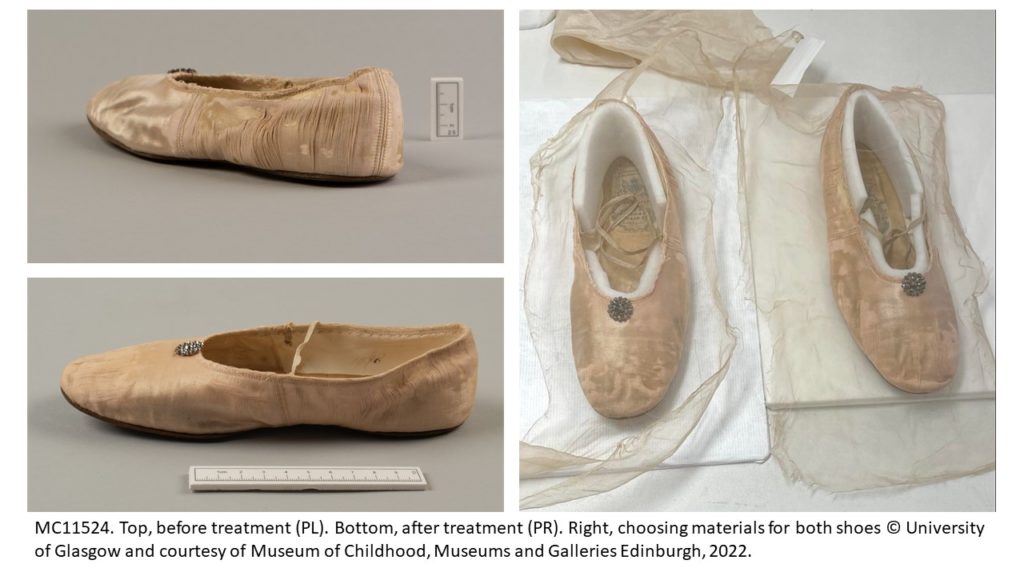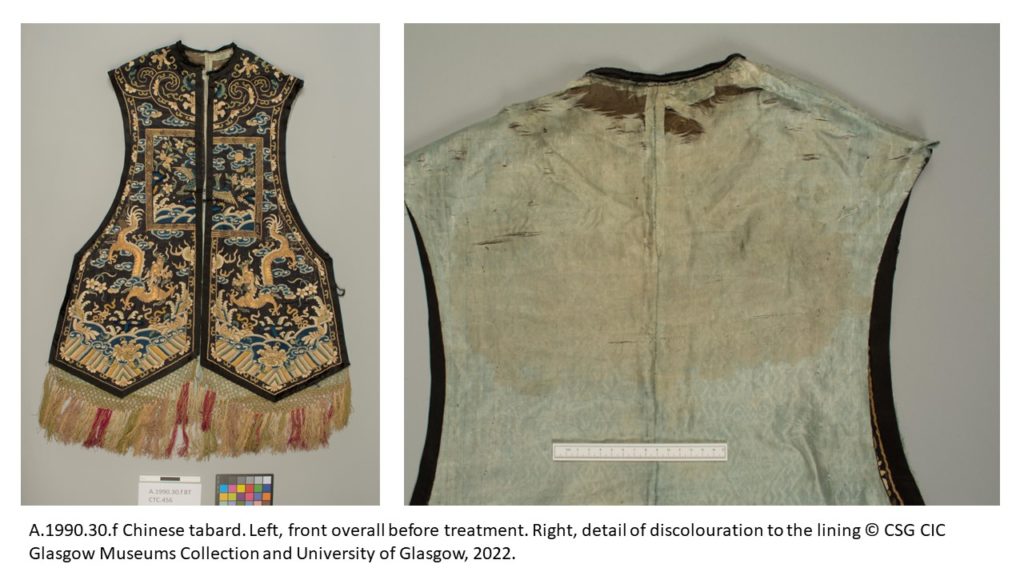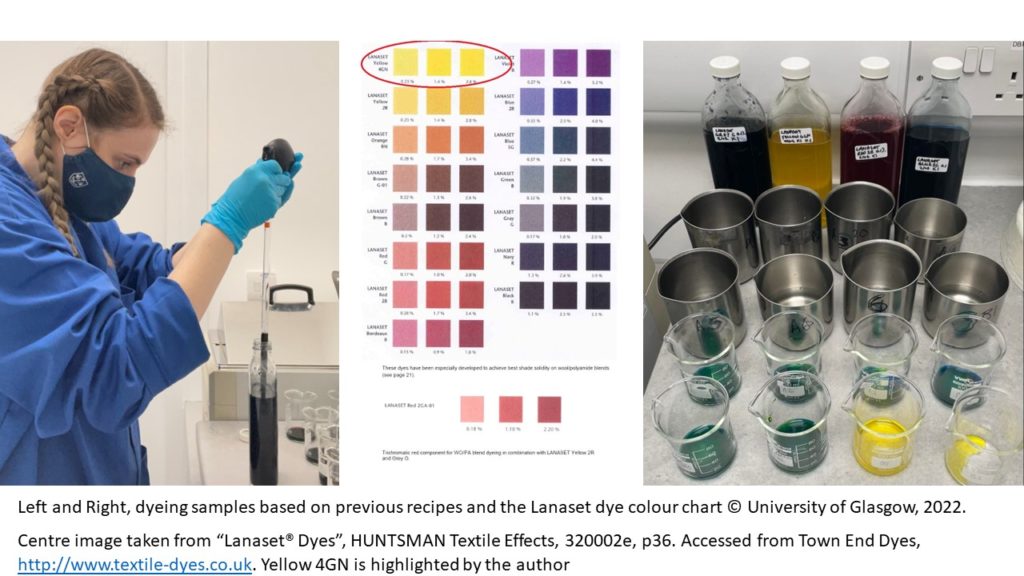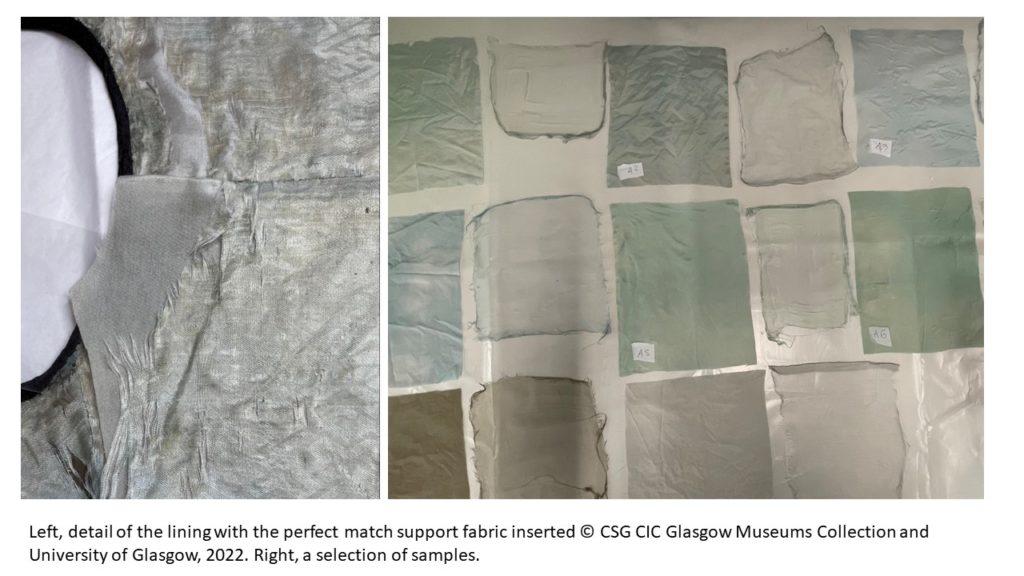
By Kirstin Ingram, Second year student, MPhil Textile Conservation
Dyeing support fabrics can sometimes feel like witchcraft even with synthetic dyes: you mix potions together, stir at a boiling pot, and turn a piece of undyed fabric into any colour of the rainbow. However, sometimes this magic can involve a lot of trial and error as support fabric needs to be the perfect colour and achieving an exact match is not always as simple as it would first seem.
While working on conservation treatments during my second year of the Textile Conservation programme, I have had the opportunity to colour match twice, firstly on a pair of children’s shoes from The Museum of Childhood (Museums and Galleries Edinburgh) which required an adhesive overlay and then for a Chinese tabard from Glasgow Museums which needed stitched patches and an overlay of the lining.
The child’s shoes were a ballet pink, a similar colour to which had been dyed several times before through other people’s treatments. This meant samples could be selected from the textile conservation dye books, a fabulous resource of previously dyed samples and recipes. With a little tweak of a recipe by adding more red and less grey a colour match was achieved in one attempt.

However, colour matching support fabric for the Chinese tabard proved more difficult than the child’s shoes. The lining of the tabard was to be conserved with a stitched patch support with an overlay of crepeline to support and protect the areas of loss from abrasion while on a mannequin. As the lining was significantly faded and discoloured in areas, multiple colours were needed to match the different areas of loss.

The lining is blue but has yellowing discolouration in areas, adding a problematic layer of complexity to the required colour – how to add yellow to blue without it becoming too green. There had been a little bit of previous dyeing for this object which was a starting point for further samples. However, for some of the variations I also had to go back to the basics of the colour swatches for the Lanaset® dyes (modified 1:2 metal complex, acid and reactive dyes for protein fibres which have high wet and light fastness) I was using. With these resources, I set to work creating and altering recipes and dyeing samples.

Although the first batch of samples did not turn out quite right, I was enjoying the process of thinking about dyeing and joined the Society of Dyers and Colourists to further my research. Through this I watched a Webinar on colour theory,[1] and it made me think about colour differently. I went back to the Lanaset® Dye handbook and looked at the different colour components of the dyes.[2] For example, Lanaset®Yellow 4GN is a greenish yellow, but by looking at the Lanaset®handbook I found that it as well as yellow and green tones, it also has hints of orange, red and turquoise.
With this information, I went back and tweaked my recipes and with a few more sample dyes I found the matches for each of the areas of loss and could progress to bulk dyeing and start stitching.

The research I undertook to help understand dye mixing led me to an episode of the conservators’ podcast, the C-Word (“Dyes in Conservation”[3]) in which Alison Lister from Textile Conservation Ltd is interviewed about dyeing. One topic discussed is the longevity of dyes and in particular the fact that conservators usually do not keep their dye stock solution for very long. This is something that I also noted while dyeing on the programme, where we usually only keep our stock solutions for up to a week. The time limit seemed quite arbitrary and has led me to research the subject for my dissertation: specifically to investigate whether dye stock solutions loose efficacy over time and what factors may be influential. During my research I will be collecting data through a questionnaire to find out how long conservators keep their stock solution for, and I hope textile conservators will be interested to share this information with me.
[1] “Contemporary Colour Theory,” Society of Dyers and Colourists, last accessed June 14th, 2022, https://colour.network/product/contemporary-colour-theory-webinar-series/.
[2] “Lanaset® Dyes,” Town End Dyes, last accessed June 14th, 2022, https://www.textile-dyes.co.uk/lanaset.pdf.
[3] “Dyes in Conservation,” The C Word, last accessed June 14th, 2022, https://thecword.show/2021/06/30/s09e08-dyes-in-conservation/.


Thank you for the mention Kirstin. Great choice of dissertation topic. Good luck with your research. I look forward to hearing your findings.